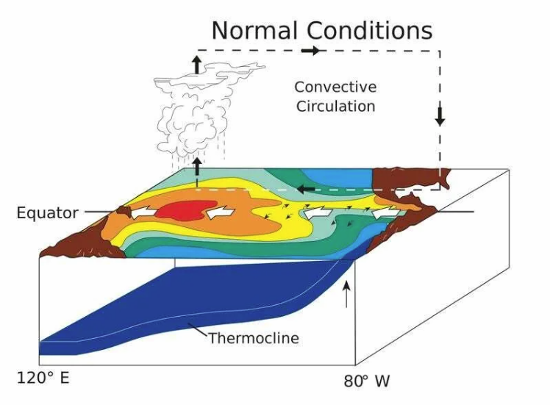Monimya Roughan is a professor in the field of oceanography at the University of New South Wales in Australia. An article published this week in The Conversation highlights what data collected from the world’s oceans is showing. Since mid-March, ocean surface waters globally have surpassed 21 Celsius (70 Fahrenheit) degrees. Since the age of remote monitoring satellites, first deployed in the 1970s, this thermometer reading is unprecedented.
Roughan notes that 90% of the heat that gets trapped in the atmosphere because of greenhouse gas emissions ends up in the ocean. Normally, the vertical displacement of warm surface water by deeper cold water offsets the heating. But that is not what is happening now.
Why wasn’t this phenomenon detected before? Because the cycling of La Niña, and El Niño events masked the overall thermodynamics. With the latest La Niña waning after three years, the cause of cooler conditions overall, we are now due for a new El Niño which should see global atmospheric temperatures rise.
Roughan notes a change in the normal upwelling of cold water off the coast of South America. This phenomenon keeps Pacific Ocean surface waters cool. But it is not happening as the new El Niño begins to take shape.
The El Niño which is also known as the back half of the Southern Oscillation cycle that repeats between every 3 and 7 years, has been responsible for creating the fire weather that plagues Australia, droughts in Indonesia and South Africa, torrential rain and flooding events in parts of South America, and disruptions to the lucrative local fisheries off South America’s coast. It is associated with Amazon rainforest loss and with years when sea ice in the Arctic is at its lowest. And El Niño is seen as contributing to the increasing range of vector-borne tropical diseases.
With the cold ocean current conveyor belt off South America impacted negatively, the western Pacific will see the ocean absorbing even more of atmospheric heat which penetrates to a depth of 2 kilometres (1.2 miles) beneath the surface. With the average ocean depth being 4 kilometres (2.4 miles), it means that half of the total volume of the ocean is being affected.
Roughan quotes from a study of just how much extra heat Earth’s atmosphere has trapped between 1960 and 2020. A subset of the data from 1971 to 2020 shows that the planet has absorbed 380 zettajoules of extra heat or the equivalent of 25 billion nuclear bombs. Consider the ocean has taken up 90% of the extra heat and you can see why we are getting into hot water which is not confined to the tropics, but rather is spreading to the poles.
An article appearing in The Washington Post on April 28, 2023, quotes a senior scientist from the U.S. National Oceanic and Atmospheric Administration (NOAA) who states “You’ve got this relentless rise of greenhouse gasses in the atmosphere….we just know unless that turns around in some way, we will continue to set records.” Another NOAA scientist notes that by 2024 as the coming El Niño strengthens we should see “new highs in global mean surface temperatures.”
A side effect of a warmer ocean is thermal expansion which threatens coastlines as sea levels rise. Warmer surface water feeds the cycle of hurricanes in the Atlantic, cyclones in the Indian Ocean, and typhoons in the Pacific. Warmer surface waters increase evaporation which supercharges rain events. Warmer surface waters reinforce air temperature warmth. The ocean-to-air water cycle sees a 2.2% increase in water vapour volume for every one Celsius (4%i per one Fahrenheit) degree increase in air temperature.
Ocean warmth is unevenly distributed with some areas warming faster than others. This is largely influenced by ocean currents. For example, the Gulf Stream off the U.S. eastern seaboard is altering temperatures and weather patterns for the U.S. northeast.
A conclusion drawn by climatologists and oceanographers states that the warming regardless of what we do to slow greenhouse gas emissions and reverse our contributions is likely “irreversible this century.” So indeed, we are in hot water like the proverbial frog in a pot sitting on top of a lit stove.








